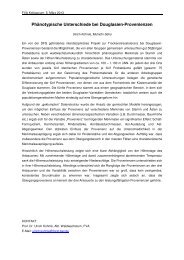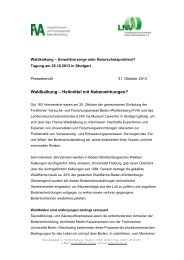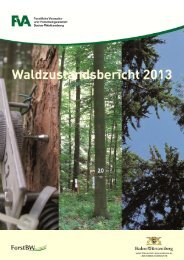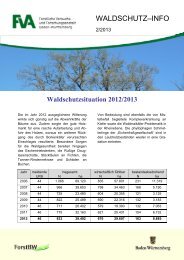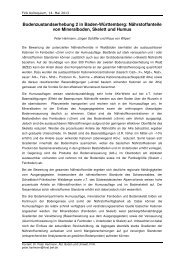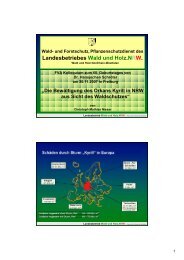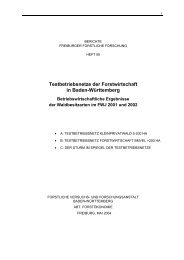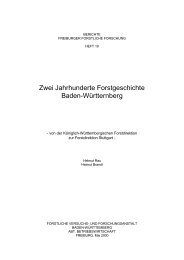Verfahren zur einzelstammweisen Volumen - Forstliche Versuchs
Verfahren zur einzelstammweisen Volumen - Forstliche Versuchs
Verfahren zur einzelstammweisen Volumen - Forstliche Versuchs
Erfolgreiche ePaper selbst erstellen
Machen Sie aus Ihren PDF Publikationen ein blätterbares Flipbook mit unserer einzigartigen Google optimierten e-Paper Software.
94 7 Summary<br />
simulating a mechanical calliper (calliper diameter). In the other, the measurement of log<br />
diameters was based on the real contour of a cross section (contour diameter). As expected,<br />
the results show that in direct comparison, the measured values of the contour diameter are<br />
always at least as big as those produced in an identical measurement plane using the<br />
calliper diameter. On average, the simulation of a mechanical calliper leads to an<br />
overestimation of 1.6 mm in diameter.<br />
With respect to the determination of diameters, rounding, which is established in forest<br />
practice and carried out according to forest guidelines (Forst-HKS), plays an important role.<br />
Rounding has its origin in the manual measurement. Diameters are unilaterally rounded<br />
down. This is also applied in the practice of electronic measurement and leads to an<br />
underestimation of the volume of nearly 3 % compared to the volume calculated using<br />
unrounded diameters.<br />
In this investigation the determination of the log length is irrelevant, as the available raw<br />
data allows a clear determination of the measured stem length and consequently, a<br />
calculation of payroll-related length is guaranteed. Therefore, volume differences between<br />
different methods are not caused by different log lengths. All volumes have been calculated<br />
on the basis of uniform log lengths.<br />
For the determination of log volume, principally different approaches were implemented:<br />
1. Determination of the log volume on the basis of calculating a cylinder volume using<br />
an ordinary mid-diameter;<br />
2. Determination of the log volume by dividing the log into sections of equal length,<br />
with the log volume as sum of all individual section volumes (cylinders);<br />
3. Determination of a reference volume, which is calculated using all available data<br />
points and thus approximates the real physical volume of the log.<br />
In contrast to the different cylinder and section volumes, the reference volume is not<br />
calculated on the basis of one or few diameters, but on the basis of the real contour of a<br />
cross section.<br />
Based on the results obtained by the simulation of different measurement methods, it can<br />
be shown how various approaches of determining diameter and volume influence the<br />
measurements results.<br />
Consequently, currently applied methods such as the measurement according to the<br />
regulations established in Germany (Rahmenvereinbarung Werksvermessung) as well as in<br />
Austria (ÖNORM L1021), are simulated on the basis of a common data base. In addition,<br />
alternative potential methods for volume determination were demonstrated and also<br />
simulated based on the available data set. The results of the simulation show that different<br />
methods for determining the volume do indeed have a relevant impact on the measurement<br />
results. The calculation of the log volume on the basis of a cylinder leads to an<br />
underestimation of the volume when compared to the reference volume (mean relative<br />
difference). There is a difference of about 3 % between the methods applied in Germany<br />
(Rahmenvereinbarung Werksvermessung) and Austria (ÖNORM L1021) referring the<br />
volume. The determination of the volume according to the ÖNORM tends to result in an<br />
underestimation of the volume compared to the volume determined according to the<br />
German guidelines. In addition to the quantitative comparison of the different methods



